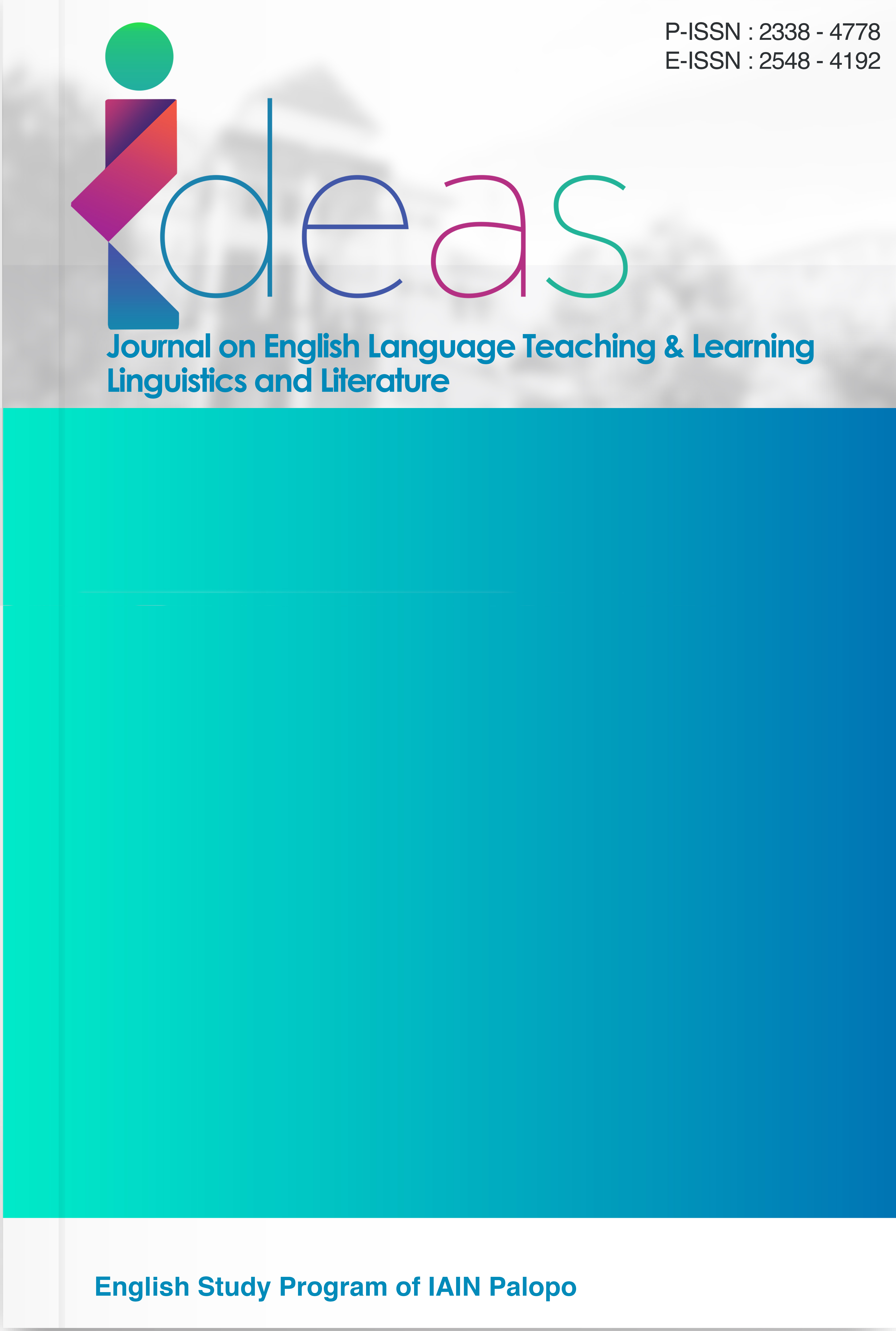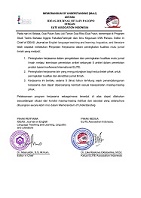News In Levels website to sharpen students’ critical thinking: Student’s Perspective
DOI:
https://doi.org/10.24256/ideas.v13i2.7650Keywords:
News in Levels, critical thinking, reading skills, English language learning, digital mediaAbstract
This study explores the explorer of News in Levels as a learning medium in enhancing reading skills and critical thinking among fifth-semester students of the English Education Program at Universitas of Indonesia. News in Levels is an online news platform that presents current events in three levels of English proficiency, allowing students to engage with content suited to their language ability. The platform not only supports literal comprehension but also encourages students to analyze information, construct arguments, and compare news across levels—core components of critical thinking. The research employed a qualitative descriptive approach, with data collected through interviews involving three students who actively use News in Levels in their learning process. The interviews focused on students’ perceptions of how the platform helps them understand texts more deeply, identify main ideas, draw conclusions, and respond to current issues reflectively and critically. Findings indicate that News in Levels assists students not only in understanding English texts but also in developing analytical thinking about news content. All three participants reported that reading news across different levels enabled them to build layered comprehension, which eventually led to deeper analysis. The platform’s audio features and simple yet informative structure made it easier for students to identify the writer’s perspective and form their own opinions based on the information read. Thus, News in Levels proves to be an effective learning medium for improving not only reading skills but also critical thinking abilities, particularly in the context of English as a foreign language learning.
References
Aboluwodi, A. (2016). Imperative of teaching critical thinking in higher institutions in Nigeria. Journal of Teaching and Teacher Education, 4(1), 9–15.
Agustina, E., & Cahyono, B. (2017). Perceptions of Indonesian Teachers and Students on the Use of Quipper School as an Online Platform for Extended EFL Learning. Journal of Language Teaching and Research, 8, 794. https://doi.org/10.17507/jltr.0804.20
Al-Shammari, A. H. (2021). Authentic materials in the classroom: A case study on students of the Faculty of Social Sciences at Kuwait University. Journal of Language and Linguistic Studies, 17(3), 1243–1257.
Alias, N. F., & Razak, R. A. (2023). Enhancing Classroom Learning: Exploring the Synergy of Microlearning and the Community of Inquiry. International Journal of Advanced Research in Education and Society, 5(4), 124–138.
Amelia, R. (2023). AN ANALYSIS OF INDONESIAN EFL PRE-SERVICE TEACHERS L2 SPEECH PRODUCTION. Indonesian Journal of Integrated English Language Teaching, 9(1), 18–32.
Azarnoosh, M., Zeraatpishe, M., Faravani, A., & Kargozari, H. R. (2016). Issues in Material Development. Sense Publisher. https://doi.org/https://doi.org/10.1007/978-94-6300-432-9
Bailey, F., & Fahad, A. K. (2021). Krashen Revisited: A Case Study of the Role of Input, Motivation, and Identity in Second Language Learning. Arab World English Journal, 12(2), 540–550.
Braun, V., & Clarke, V. (2021). Thematic analysis: A practical guide.
Brevik, L. M. (2019). Explicit reading strategy instruction or daily use of strategies? Studying the teaching of reading comprehension through naturalistic classroom observation in English L2. Reading and Writing, 32(9), 2281–2310.
Brookfield, S. (2013). Teaching for Critical Thinking. In V. Wang (Ed.), Handbook of Research on Teaching and Learning in K-20 Education (pp. 1–16). IGI Global Scientific Publishing. https://doi.org/10.4018/978-1-4666-4249-2.ch001
Camacho Vásquez, G., & Ovalle, J. C. (2019). Video Games: Their Influence on English as a Foreign Language Vocabulary Acquisition. GIST – Education and Learning Research Journal, 19(19), 172–192. https://doi.org/10.26817/16925777.707
Chaffee, R. K., Briesch, A. M., Johnson, A. H., & Volpe, R. J. (2017). A meta-analysis of class-wide interventions for supporting student behavior. School Psychology Review, 46(2), 149–164.
Colorafi, K. J., & Evans, B. (2016). Qualitative descriptive methods in health science research. HERD: Health Environments Research & Design Journal, 9(4), 16–25.
Cottrell, S. (2021). Skills for success: Personal development and employability. Bloomsbury Publishing.
Creswell, J. W., & Poth, C. N. (2016). Qualitative inquiry and research design: Choosing among five approaches. Sage publications.
Ennis, R. H. (2015). Critical thinking: A streamlined conception. In The Palgrave handbook of critical thinking in higher education (pp. 31–47). Springer.
Facione, P. A. (2011). Critical thinking: What it is and why it counts. Insight Assessment, 1(1), 1–23.
Gardner, D., & Davies, M. (2014). A new academic vocabulary list. Applied Linguistics, 35(3), 305–327.
Guo, L., & Xu, L. (2021). The effects of digital transformation on firm performance: Evidence from China’s manufacturing sector. Sustainability, 13(22), 12844.
Halpern, D. F. (2013). Thought and knowledge: An introduction to critical thinking. Psychology Press.
Huang, J. (2022). Relationships between EFL learners’ background, motivational, instructional, and ICT‐related characteristics, and writing performance: Evidence from 13 educational systems. Psychology in the Schools, 59(3), 495–514.
Johansson, M. (2019). Digital and written quotations in a news text: The hybrid genre of political opinion review. Analyzing Digital Discourse: New Insights and Future Directions, 133–162.
Jonassen, D. H. (2010). Learning to solve problems: A handbook for designing problem-solving learning environments. Routledge.
Khabib, S., Rahayu, E. Y., & Triristina, N. (2023). PRE-SERVICE EFL TEACHERS PERCEPTIONS TOWARD THE MATERIALS DEVELOPMENT OF HYBRID LEARNING MODEL. Premise: Journal of English Education and Applied Linguistics, 12(1), 214–234.
Krashen, S., & Terrell, T. (1983). the_Natural_Approach.pdf. In Stanford Education (p. 191). http://web.stanford.edu/~hakuta/www/LAU/ICLangLit/NaturalApproach.htm
Kuhn, D. (1999). A developmental model of critical thinking. Educational Researcher, 28(2), 16–46.
Li, L., & Zhang, J. (2021). Successful online learning experience: Perceptions of Chinese undergraduate students. Journal of Education and Learning, 10(1), 74–81.
Luo, Q., Chen, L., Yu, D., & Zhang, K. (2023). The mediating role of learning engagement between self-efficacy and academic achievement among Chinese college students. Psychology Research and Behavior Management, 1533–1543.
Masruddin, M., & Al Hamdany, M. Z. (2023). Students’ motivation in learning English in Islamic higher education. FOSTER: Journal of English Language Teaching, 4(4), 199-207.
Madehang, M., Masruddin, M., & Iksan, M. (2024). Reflecting on the Implementation of Online English Learning in Islamic Higher Education: Lecturers and Students’ Perspectives. International Journal of Asian Education, 5(3), 183-197.
Nasution, D. S. (2023). The Role of Technology in English Language Learning: A Quantitative Examination of Student Performance, Engagement, and Motivation. West Science Interdisciplinary Studies, 01(12), 690–701.
Nasution, Z., Pasaribu, S., Surianto, S., Ridwan, A., & Nasution, H. B. (2023). Wahdatul ‘Ulum Perspective Systemic Thinking: Study Integration of Science in Islamic Education. AL-ISHLAH: Jurnal Pendidikan, 15(2), 1842–1849.
Palinkas, L. A., Horwitz, S. M., Green, C. A., Wisdom, J. P., Duan, N., & Hoagwood, K. (2015). Purposeful sampling for qualitative data collection and analysis in mixed-method implementation research. Administration and Policy in Mental Health and Mental Health Services Research, 42, 533–544.
Paul, R., & Elder, L. (2019). The Thinker’s Guide to Ethical Reasoning. Rowman & Littlefield.
Prapelia, C. R., & Fadhilawati, D. (2024). Stimulating the Reading Proficiency of 10th Grade Students Through the Application of Wordwall in Recount Text. Jurnal Riset Rumpun Ilmu Bahasa, 3(1), 41–50.
Rahayu, S. A., Qomariah, D. N., Nuraeni, D., & Nenci, I. S. (2023). Inisiatif Keterlibatan Orangtua Dalam Pendidikan Anak. Edu Happiness: Jurnal Ilmiah Perkembangan Anak Usia Dini, 2(1), 25–42. https://doi.org/10.62515/eduhappiness.v2i1.126
Rangkuti, R., Khairina, J., Zulfan, Z., & Yusuf, M. (2023). The attitude of Indonesian senior high school students towards learning English. World Journal of English Language, 13(6), 460.
Sandelowski, M. (2000). Whatever happened to qualitative description? Research in Nursing & Health, 23(4), 334–340.
Sari, M. I., & Putri, A. A. (2022). Exploring online learning tools used by EFL teachers during the COVID-19 pandemic. Journal of Foreign Language Teaching and Learning, 7(1), 61–76.
Setiawan, B., Nugraha, D. P., Irawan, A., Nathan, R. J., & Zoltan, Z. (2021). User innovativeness and fintech adoption in Indonesia. Journal of Open Innovation: Technology, Market, and Complexity, 7(3), 188.
Setiawan, R., & Nungki Nurbani, A. (2023). Envisioning Critical Literacy through Literary Work for EFL Pre-Service Teachers. J-SHMIC: Journal of English for Academic, 10(1), 35–50. https://doi.org/10.25299/jshmic.2023.vol10(1).11252
Smith, B., & Sparkes, A. C. (2016). Routledge Handbook of Qualitative Research in Sport and Exercise (1st ed.). Routledge. https://doi.org/https://doi.org/10.4324/9781315762012
Tisdell, E. J., Merriam, S. B., & Stuckey-Peyrot, H. L. (2025). Qualitative research: A guide to design and implementation. John Wiley & Sons.
Walsh, S., & Mann, S. (2019). The Routledge Handbook of English Language Teacher Education (1st ed.). Routledge. https://doi.org/https://doi.org/10.4324/9781315659824
Wang, M. (2020). Chinese EFL Teachers‟ Perceptions towards Blended Learning. International Journal of Languages, Literature and Linguistics, 6(2), 117–121. https://doi.org/10.18178/ijlll.2020.6.2.262
Downloads
Published
Issue
Section
Citation Check
License
Copyright (c) 2025 Hanifah Azhari, Robiatul Adawiyah , Eliasanti Agustina

This work is licensed under a Creative Commons Attribution-ShareAlike 4.0 International License.
Authors retain copyright and grant the journal right of first publication with the work simultaneously licensed under an Attribution-ShareAlike 4.0 International (CC BY-SA 4.0) that allows others to share the work with an acknowledgement of the work's authorship and initial publication in this journal.
Authors are able to enter into separate, additional contractual arrangements for the non-exclusive distribution of the journal's published version of the work (e.g., post it to an institutional repository or publish it in a book), with an acknowledgement of its initial publication in this journal.
Authors are permitted and encouraged to post their work online (e.g., in institutional repositories or on their website) prior to and during the submission process, as it can lead to productive exchanges, as well as earlier and greater citation of published work (See the Effect of Open Access)




